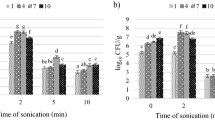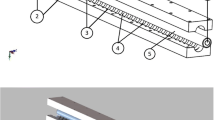Abstract
Novel technologies that involve non-thermal processes have been investigated in the last two decades as full or partial alternatives to conventional heat treatment. The main objective of this study was to evaluate the survival of single or strain cocktail of Escherichia coli, Saccharomyces cerevisiae, and a yeast cocktail in orange (pH 3.5; 9° Brix) and/or apple (pH 3.1; 12° Brix) juices and in 0.1% w/w peptone water processed by two non-thermal techniques: high-intensity ultrasound (USc) and/or short-wave ultraviolet radiation (UV-C). USc treatments (20 kHz, 95 µm-wave amplitude) were performed using a stainless steel continuous flow cell with a 13-mm probe (0.2 L/min; 40°C). The UV-C device consisted of a 90-cm long UV-C-lamp (100 W) placed inside a glass tube leaving an annular flow space (0.2 L/min; 40°C). Inoculated systems were recirculated through simultaneous or consecutive USc and UV-C devices and samples were taken at preset time intervals. Microbial populations were monitored by plate count technique. In peptone water and apple juice, UV-C radiation provoked higher E. coli ATCC 35218 inactivation than USc treatment. E. coli ATCC 35218 and its cocktail were more sensitive than S. cerevisiae KE162 and the cocktail of yeasts. UV-C efficiency was highly dependent on media nature. The poor single effect of UV-C light in orange juice was enhanced by the combination with USc. Combined treatment was more effective in simultaneous rather than in a series of USc − UV-C arrangement.




Similar content being viewed by others
References
Alzamora, S. M., López-Malo, A., & Tapia, M. S. (2000). Overview. In S. Alzamora, M. S. Tapia, & A. López-Malo (Eds.), Minimally processed fruits and vegetables. Fundamental aspects and applications (pp. 1–9). Maryland, USA: Aspen Publishers, Inc.
Bintsis, T., Litopoulou-Tzanetaki, E., & Robinson, R. (2000). Existing and potential applications of ultraviolet light in the food industry. A critical review. Journal of the Science of Food and Agriculture, 80, 637–645.
Ferrante, S., Guerrero, S., & Alzamora, S. M. (2007). Combined use of ultrasound and natural antimicrobials to inactivate L. monocytogenes in orange juice. Journal of Food Protection, 70, 1850–1857.
Guerrero, S., López-Malo, A., & Alzamora, S. M. (2001). Effect of ultrasound on the survival of Saccharomyces cerevisiae influence of temperature, pH and wave amplitude. Innovative Food Science and Emerging Technologies, 2, 31–39.
Guerrero, S., Tognon, M., & Alzamora, S. M. (2005). Modeling the response of S.cerevisiae to the combined action of ultrasound and low weight chitosan. Food Control, 16, 131–139.
Guerrero-Beltrán, J. A., & Barbosa-Cánovas, G. V. (2004). Review: advantages and limitations on processing foods by UV light. Food Science and Technology International, 10, 137–147.
Koutchma, T. (2009). Advances in ultraviolet light technology for non-thermal processing of liquid foods. Food and Bioprocess Technology, 2, 138–155.
Litved, H., & Cripps, S. J. (1999). Removal of particle-associated bacteria by prefiltration and ultraviolet irradiation. Aquaculture Research, 30, 445–450.
Lopez-Malo, A., Guerrero, S., & Alzamora, S. M. (2005). Inactivation kinetics of Saccharomyces cerevisiae and Listeria monocytogenes in apple juice processed by novel technologies. Proceedings of 2nd Mercosur Congress on Chemical Engineering. 4th Mercosur Congress on Process Systems Engineering. Paper N° 0681, E-papers Serviços Editoriais, Brasil.
Marquenie, D., Geeraerd, A. H., Lammertyn, J., Soontjens, C., Van Impe, J. F., Michiels, C. W., et al. (2003). Combinations of pulsed white light and UV-C or mild heat treatment to inactivate conidia of Botrytis cinerea and Monilia fructigena. International Journal of Food Microbiology, 85, 185–196.
Morgan, R. (1989). UV “green” light disinfection. Dairy Industries International, 54, 33–35.
Oteiza, J., Giannuzzi, L., & Zaritzky, N. (2009). Ultraviolet treatment of orange juice to inactivate E. coli O157:H7 as affected by native microflora. Food and Bioprocess Technology, doi:10.1007/s11947-009-0194-y (in press)
Pagán, R., Mañas, P., Raso, J., & Condón, S. (1999). Bacterial resistance to ultrasonic waves under pressure at nonlethal (manosonication) and lethal (manothermosonication) temperatures. Applied and Environmental Microbiology, 65, 297–300.
Rhaman, M. S. (1999). Light and sound in food preservation. In M. S. Rhaman (Ed.), Handbook of food preservation (pp. 673–686). New York: Marcel Dekker.
Rhan, R. (1997). Potassium iodide as a chemical actinometer of 254 nm radiation: use of iodate as an electron scavenger. Photochemistry and Photobiology, 66, 450–455.
Schenk, M., Guerrero, S., & Alzamora, S. M. (2008). Response of some microorganisms to ultraviolet treatment on fresh-cut pear. Food and Bioprocess Technology, 1, 384–392.
Shama, G. (1999). Ultraviolet light. In R. K. Robinson, C. Batt, & P. Patel (Eds.), Encyclopedia of food microbiology (pp. 2208–2214). London: Academic Press.
Sutton, J. C., Yu, H., Grodzinski, B., & Johnstone, M. (2000). Relationships of ultraviolet irradiation dose of inactivation of pathogen propagules in water and hydroponic nutrient solutions. Canadian Journal of Plant Pathology, 22, 300–309.
Unluturk, S., Atilgan, M., Handan Baysal, A., & Tari, C. (2008). Use of UV-C radiation as a non-thermal process for liquid egg products (LEP). Journal of Food Engineering, 85, 561–568.
US FDA. (2000). 21 CFR part 179. Irradiation in the production, processing and handling of food. Federal Register, 65, 71056–71058.
US FDA (2004). Guidance for Industry: Juice HACCP Hazards and Controls Guidance First Edition; Final Guidance. Available at http://www.fda.gov/Food/GuidanceComplianceRegulatoryInformation/GuidanceDocuments/Juice/ucm072557.htm
Yaun, B. R., Summer, S. S., Eifert, J. D., & Marcy, J. E. (2004). Inhibition of pathogens on fresh produce by ultraviolet energy. International Journal of Food Microbiology, 90, 1–8.
Yousef, A. E., & Marth, E. H. (1988). Inactivation of Listeria monocytogenes by ultraviolet energy. Journal of Food Science, 53, 571–573.
Acknowledgements
The authors would like to acknowledge the financial support from Universidad de Buenos Aires (X821 and X005 projects) and CONICET (PIP5473 project).
Author information
Authors and Affiliations
Corresponding author
Rights and permissions
About this article
Cite this article
Char, C.D., Mitilinaki, E., Guerrero, S.N. et al. Use of High-Intensity Ultrasound and UV-C Light to Inactivate Some Microorganisms in Fruit Juices. Food Bioprocess Technol 3, 797–803 (2010). https://doi.org/10.1007/s11947-009-0307-7
Received:
Accepted:
Published:
Issue Date:
DOI: https://doi.org/10.1007/s11947-009-0307-7




